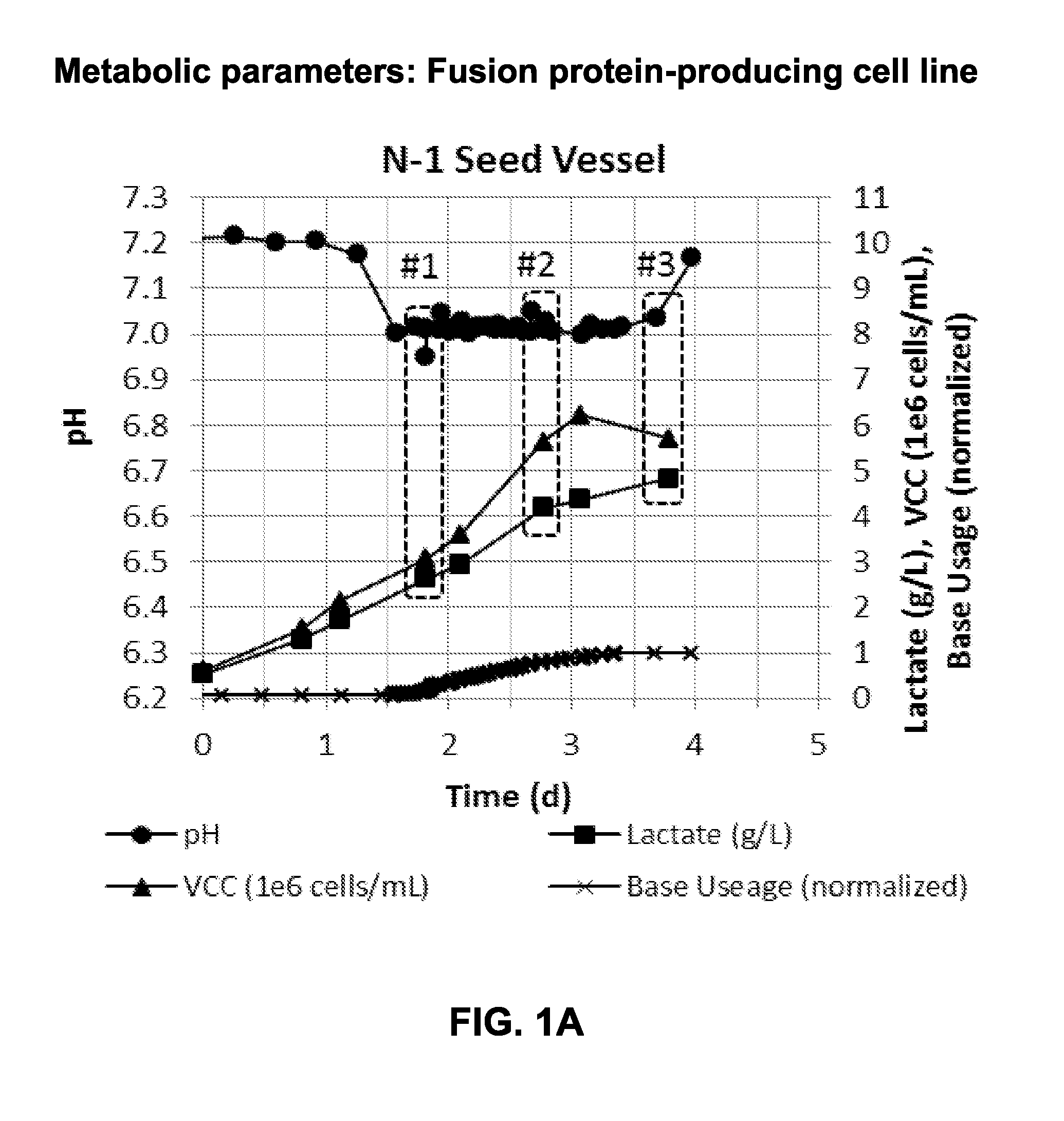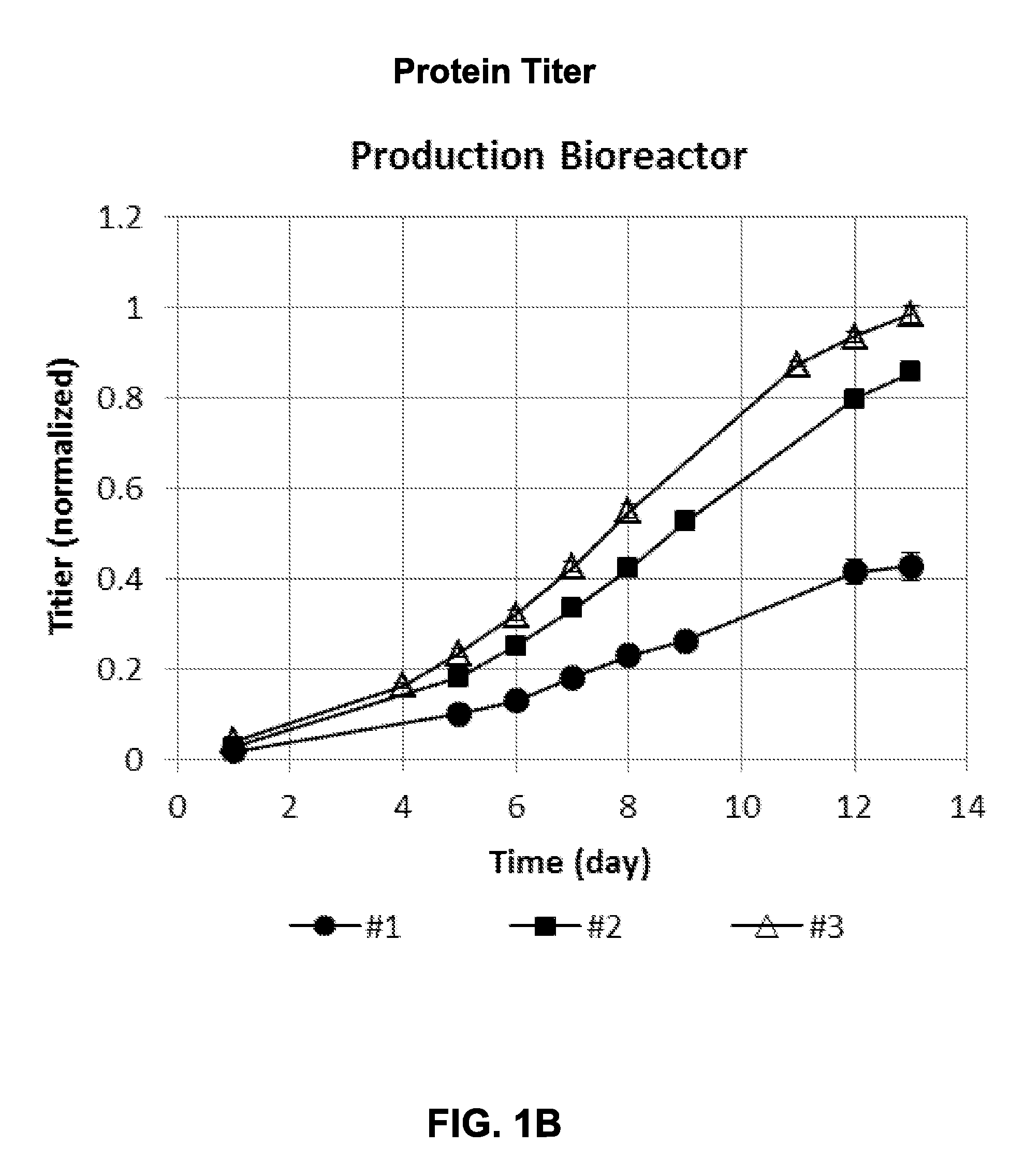Metabolically optimized cell culture
a cell culture and metabolic optimization technology, applied in the field of metabolic optimization cell culture, can solve the problems of early shift to lactate consumption, and achieve the effect of increasing productivity
- Summary
- Abstract
- Description
- Claims
- Application Information
AI Technical Summary
Benefits of technology
Problems solved by technology
Method used
Image
Examples
example 1
Determining Metabolic Shift Parameters: Fusion Protein-Producing Cell Line
[0136]CHO cells were transfected with DNA expressing a fusion protein. The fusion protein-producing CHO cell line was incubated in a seed vessel culture, in proprietary media containing soy, and parameters such as online pH, offline lactate and viable cell count, were measured and recorded to determine metabolic state (#1, #2, or #3 of FIG. 1A). Base usage was also monitored and normalized to 1 for this cell line (FIG. 1A).
[0137]Cells under condition #1 and condition #2 were used to inoculate replicate production bioreactors when the pH was controlling at the bottom end of the control range and lactate and VCC were increasing. Cells under condition #3 were inoculated when the pH was starting to increase off the bottom of the control range, i.e., base usage had stopped, indicating lactate remetabolization (i.e., consumption). Cell growth in condition #3 had entered post-exponential growth phase. All production ...
example 2
Determining Metabolic Shift Parameters, Antibody-Producing Cell Line
[0140]An antibody-producing CHO cell line seed vessel was used to inoculate replicate production bioreactors similar to Example 1, however in chemically defined medium. Four different metabolic states were measured (monitoring offline pH, lactate and viable cell counts—#1, #2, #3, and #4 of FIG. 2A). VCC continued to increase during the duration of the seed vessel incubation when production bioreactors were inoculated.
[0141]Condition #1 was inoculated very early in the seed train when the pH was still at the top end of the control range and when the lactate was low but increasing. Condition #2 was inoculated when the pH was starting to decrease and lactate was increasing and approaching peak levels. Condition #3 was inoculated when the pH was near the bottom of the control range and lactate levels had plateaued. Condition #4 was inoculated when the pH was starting to increase off the bottom of the control range and ...
example 3
Optimizing Bioreactor Titer Production by Modifying Final Viable Cell Concentration
[0144]CHO cells were transfected with DNA expressing a protein of interest. The antibody-producing CHO cell line was incubated in a seed vessel culture, in proprietary media, and parameters such as lactate and viable cell concentration were measured and recorded to determine metabolic state of the cells in the N-2 and N-1 seed train cell cultures. As shown in FIG. 4, cells cultured in a first seed train culture (N-2) to a viable cell density of greater than 3.0×106 cells / mL, e.g., 4.5×106 cells / mL (diamond), resulted in a reduced rate of lactate accumulation throughout culture without affecting cell growth in either the first seed train culture (N-2) or the second seed train culture step (N-1). Lower peak lactate concentrations in a second seed train culture were achieved after cells in the first seed train culture (N-2) were grown to a VCC of greater than 3.0×106 cells / mL (diamond). Taken together, t...
PUM
| Property | Measurement | Unit |
|---|---|---|
| concentration | aaaaa | aaaaa |
| pH | aaaaa | aaaaa |
| pH | aaaaa | aaaaa |
Abstract
Description
Claims
Application Information
 Login to View More
Login to View More - R&D
- Intellectual Property
- Life Sciences
- Materials
- Tech Scout
- Unparalleled Data Quality
- Higher Quality Content
- 60% Fewer Hallucinations
Browse by: Latest US Patents, China's latest patents, Technical Efficacy Thesaurus, Application Domain, Technology Topic, Popular Technical Reports.
© 2025 PatSnap. All rights reserved.Legal|Privacy policy|Modern Slavery Act Transparency Statement|Sitemap|About US| Contact US: help@patsnap.com



